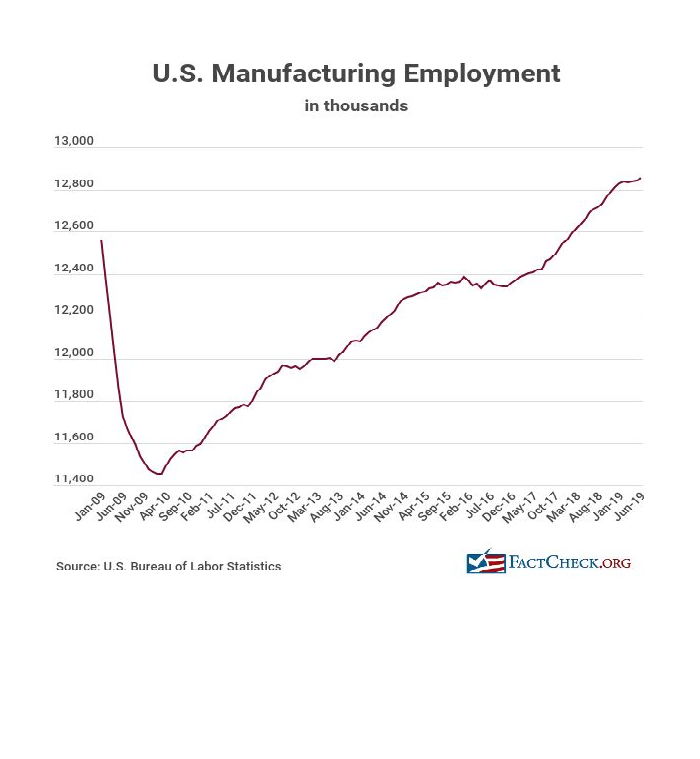This week’s article begins a series of short articles on why manufacturing is important to the America economy. Our country’s Founding Fathers recognized the importance of developing a domestic manufacturing base instead of continuing to rely on imports from England, France, and the Netherlands. They established the U.S. patent system and protected the developing manufacturing industry with tariffs to discourage imports. This allowed the United States to be the world’s number one manufacturer for more than 100 years, accounting for as much as 25 percent of global manufacturing output in 2007. In 2010, China overtook the U.S. to become the world’s top manufacturing country by output.
The first reason why manufacturing is important is: Manufacturing Supplies Millions of Jobs
Manufacturing is the engine that drives American prosperity and is the foundation of the U.S. economy and the basis for its middle class. In February 2020, manufacturing employed 12.6 million workers. According to the National Association of Manufacturers’ facts about manufacturing, “manufacturers contributed $2.381 trillion to the U.S. economy in the fourth quarter of 2019, a new all-time high…Overall, manufacturing accounted for 11% of GDP in the economy.”
In addition, “For every $1.00 spent in manufacturing, another $2.74 is added to the economy. That is the highest multiplier effect of any economic sector. In addition, for every one worker in manufacturing, there are another five employees hired elsewhere.”
The U.S. lost 5.8 million jobs in manufacturing from the year 2000 to 2010 due to a combination of factors, such as the offshoring of jobs to Asia, especially to China, increased productivity of American workers, automation, and robots, as well as the domestic outsourcing of service jobs within a manufacturing company, such as accounting and payroll services, janitorial services, cafeteria/food services, and legal departments. Thus, jobs that may have been classified as manufacturing are now classified as service jobs.
The below chart shows that the U. S. has regained about 1.5 million jobs since the end of the recession.

American workers achieve a high productivity rate year in and year out, and the growing trend of training in “Lean manufacturing” has accelerated the increase in the productivity of American workers
In 2019, the ten states with the largest manufacturing workforces were: California, Texas, Ohio, Michigan, Illinois, Pennsylvania, Indiana, Wisconsin, South Carolina, and New York. California’s manufacturing workforce of more than 1.2 million exceeds Illinois and Pennsylvania’s combined manufacturing workforce
A blog article by Alex Carrick of January 14, 2019 on the website www.constructconnect.com, states: “The five major contributors to U.S. manufacturing employment are: transportation equipment, a 13.2% share; food manufacturing, 12.9%; fabricated metal products, 11.7%; machinery, 8.9%; and computer and electronic products, 8.4%.
Michigan (with an 11.4% share) leads all states in number of transportation equipment jobs. It’s followed by Indiana (8.2%). California and Ohio (each with 7.3% shares) are tied for third.
By a wide margin, California is out front among states in number of food manufacturing jobs.
California and Texas provide the most ‘fabricated metal product’ jobs; Ohio is in third spot.
Texas, which is big in oil and gas drilling equipment, is the nation’s leader in machinery manufacturing jobs.
More than a quarter of U.S. ‘computer and electronic products’ manufacturing jobs are in California. Second-place Texas has only about one-third of California’s contingent.”
The sooner we reopen all manufacturing, instead of just allowing manufacturers in critical industries to remain open, the sooner we will get millions of manufacturing workers off the unemployment roles and back to producing the goods we need to remain a strong industrial nation, while protecting the health and national security of all Americans.
[…] ports, trucking routes, trains, and supply lines to be humming again. Manufacturing is the foundation of the U.S. economy and our country’s large middle […]